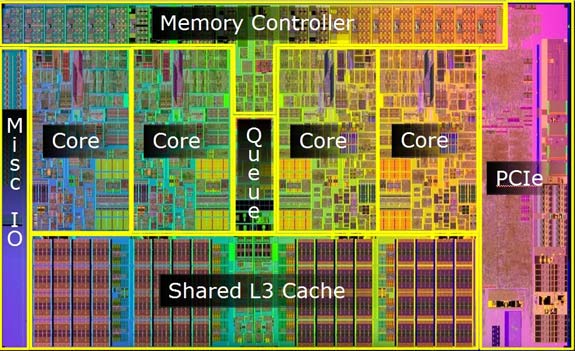Intel Core i5, Core i7 800 Processors and P55 Express
One of the major changes brought forth with Intel's new Core i5 and i7 800 series processors is their packaging. These new processors are configured with 1156 contact pads on their underside, as opposed to the 1366 pads used on the original Core i7 processors.
Intel Core i5 750 Processor, LGA1156 Packaging
The changes made to the Core i5 and i7 800 series processors' packaging were necessitated by the integration of PCI Express connectivity, the dual-channel memory controller configuration, and enhancements / changes made to the chip's power delivery configuration. Due to the fact that these new processors use different packaging, a new socket is also necessary of course. More on that a little later.
The Core i5 chip pictured above looks nearly identical to a Core i7 800 series chip. In fact, the two processor lines differ only in their support for HyperThreading--the Core i7 800 series supports HT, the Core i5 does not. The processors are outfitted with integrated heat spreaders and have a number of surface mounted components on their undersides. There are also a number of contact pads on the top side of the chips.

Lynnfield Die Map
Underneath the heat spreader lies a native, quad-core CPU design, manufactured using Intel's 45nm process. The image above is a map of a Lynnfield die; it details the positions of each of the processor's major functional blocks. As you can see, the quad-execution cores are situated about in the center of the die, sandwiched between the new dual-channel DDR3 memory controller and 8MB of shared L3 cache. Miscellaneous I/O resides on the left and 16 lanes of PCI Express 2.0 are on the right. The integration of the memory controller and PCI Express lanes on the chip, essentially eliminated the need for a northbridge, like previous Intel chipsets. Hence, the single-chip P55 Express was born.
As we've already mentioned, Lynnfield is based on the Nehalem microarchitecture. But the changes introduced with Lynnfield make it quite different from the first batch of Core i7s. The changes made with Lynnfield culminate in a product that Intel claims is 20% faster than the previous generation Core 2 processor series, while also offering ~50% lower idle power consumption, and because the accompanying P55 Express chipset is a single chip design, there is a 40% total package size reduction (CPU + Chipset).

Core i5 and i7 800 Series Turbo Mode Illustration
Aside from the integration of on-die PCI Express connectivity, perhaps the most significant change made with Lynnfield in is regard to its Intel Turbo Mode functionality. With the original Core i7s, Turbo Mode allowed the chips to operate at one or two speed-bins above their "stock" frequencies, thermal and power envelopes permitting. With the new Lynnfield-based Core i5 and Core i7 800 series processors, however, Turbo Mode is much more flexible, and powerful.
With Lynnfield-based processors, Turbo Mode allows the chips to operate at up to 5 speed bins above stock. As long as the processors are running within specified thermal and power limits, when a single-threaded workload is detected, the clock speed on a single execution core will be increased up to 5 speed bins. When a lightly threaded workload is detected, frequencies will be increased up to 4 speed bins. And with a highly threaded workload, frequencies will increase 1-2 speed bins. As a result, the Core i7 870 will hit speeds up to 3.6GHz, the i7 860 up to 3.46GHz, and Core i5 750 up to 3.2GHz.






